Mini-safari
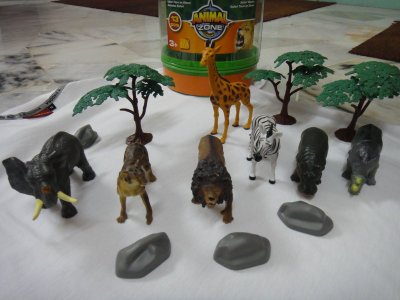
I've been on the lookout for the Wild Toob, but without any luck.
Color me surprised when I saw this in a KL Toys R Us. And for a reasonable RM44.95 (S$18.05) too.
The box said 13 pieces, but there are only 7 animals. There are 3 trees and 4 rocks. Yes, 14 pieces altogether.
The animals look reasonably realistic and in-scale. The only flaw is that the colors are a bit too dark.
If you want realistic and accurate-colored animals, each one costs RM29.90 (S$12). I remember it costs S$10 in Singapore, so it is more expensive in KL.
And that is the surprising part. Many things are now more expensive in Malaysia even with the exchange rate at S$1 to RM2.49.
Fruits for sale!
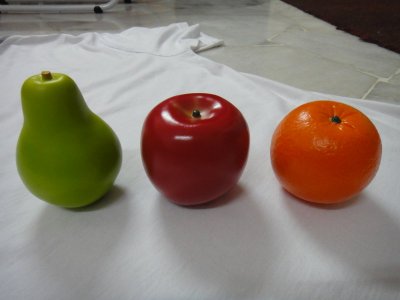
The Mothercare in Malaysia does not carry the Melissa & Doug fruits/vegetables set. However, it sells the bulk fruits/vegetables, at six a pack.
Each pack is RM79.90 (S$32.10), which is pretty expensive. I don't need six of each fruit either.
However, I spotted a 50% off sticker. Wow, that makes it a bargain!
Three packs are as many as Missus would allow me to buy. Her eyes were already as wide as saucers.
Surprise find

I have been looking for this part for a long time.
This is not an ordinary track switcher. It has an auto-switch feature, meaning the switch will change position after a train passes it.
It is surprisingly cheap at RM19.90.
I would love to get a few, but Missus would allow only one.
Record high COE again
COE bidding 19/12:
| A (<=1.6L) | $81,889 |
| B (>1.6L) | $93,501 |
| Open | $95,990 |
If a person earns $60k a year, the COE is an additional tax of 13.3%.
Who says Singapore doesn't have a progressive tax system?
Personal tax is low. However, you pay for what you use.
Video encoding has never been simpler
Recently, I needed to convert some DVDs to low-bandwidth video files to watch on-the-go.
I used a variety of tools to extract the DVD to the HD. They are k9copy, HD Decrypter (trial) and DVD Decrypter.
It took a surprisingly long time to extract the DVDs. Library DVDs are full of scratches. I had to borrow multiple copies of the same disc to get an error-free rip.
Then, I use HandBrake to convert at my own leisure. It is a frontend to the encoders.
Parameters:
| Resolution | 320x240 |
| Video codec | x264 |
| Preset | slower |
| Options | ref=4:bframes=8:subme=10 |
| CRF | 22 |
| Denoise | weak |
| Audio codec | faac |
| Audio | mono, 22.05 kHz, 32 kbps |
CRF (Constant Rate Factor) is an "arbitrary" number. 20 is the default and gives good result. RF 22 results in 30% smaller file with some quality loss. On the other hand, RF 18 gives almost 50% larger file!
For high-quality, I simply change these parameters:
| Resolution | 640x480 |
| CRF | 20 |
| Audio | stereo, 32 kHz, 96 kbps |
Video encoding has never been simpler!
The fiscal cliff
It will be fine until it is not. Then, hell will break loose, all at once.
One question I have is, why aren't we seeing high inflation with the endless money printing?
(There is inflation, but it is not proportional to the scale of money printing.)
I think there are two reasons for that.
First, there is profit margin. It is being eroded everyday. It will be gone one day.
Second, the effect is not linear. The system can absorb the excess money, until suddenly it is not able to. There will be hyperinflation as people realize the real value of their money.
Although an econmic depression calls for deflation, central banks and Governments all over the world are refusing to face reality and are printing to inflate their economies.
This is why I think there will be hyperinflation. There is no limit to fiat currency. But the assets remain the same. Too much money chasing the same quantity of assets means prices will go up.
The money printers can get away with it as long as people have faith in their currencies. But once there is an alternative, their currencies will no longer have any value.
The $64,000 question is, how do we prepare for that day?
First impressions of Windows 8
I had the Windows 8 installation disc for a couple of months, but I didn't have a spare machine to try it on.
Finally, it dawned to me to check if Windows 8 supported dual booting. It does — out-of-the-box.
I quickly shrank my disk partition by 40 GB and installed Windows 8 on it.
Installation was pretty fast and smooth. It used around 24 GB. That is even bigger than Windows 7 at 20 GB.
An OS requiring so much disk space is an out-dated thinking, where space was no object. Space is a premium on tablets and SSDs.
The typical Android tablet has 16 GB flash. That's not even enough for the OS itself!
Back to the OS. First screen: the Metro Start screen. Wow, is it ugly. The Metro apps are usable with a mouse, but it is obvious they are designed with touch in mind.
But it is okay. One click on the Desktop tile brings us back to the familiar desktop.
Except, where is the Start button? How do I find the programs and the Control Panel?
Well, I missed the tutorial that the four corners are now hotspots. Move the mouse to the lower-left corner and right-click. Okay, so that is how to access the programs.
Vista started the dumbing-down trend. It did so by moving the seldom-used features one-level deeper. Windows 8 went one step further: it hid them totally in the normal view. We have to go out of our way to invoke the familiar windows and options. They are mostly there, but it takes some digging to find them.
Math time again: cost per piece
Shopping for a box of chocolate:
| 16 | $7.80 |
| 24 | $12.90 |
| 30 | $11.90 |
| 32 | $23.95 |
No brainer which one is most worth it.
Forbidden words
There is only a facade of freedom in Singapore. Test it mildly, and you'll hit a solid brick wall.
For example, you shouldn't say what the HDB void decks can be used for. You might need to go for a holiday in another country.
And strike.
Someone decreed a long time ago that there should not be any strike in Singapore, so there were none. (Except for 1984. OTC was a brave man. He deserved my respect just for that.)
Until now. Over 200 SMRT bus drivers strike over their pay and living conditions.
I'm generally amused when I hear Singaporeans condemn the strike. It's an illegal strike, they say. (They really amuse me.)
It depends whether you think they strike as their first course of action or their last.
If it's their last — and it is — I think it is justifiable.
Bloatware
What I found when I was looking for the latest drivers for my netbook.
| Audio driver | 108.6 MB |
| Mouse driver | 62.3 MB |
| Video driver | 120.5 MB |
| Wireless driver | 32.3 MB |
60 MB for a mouse driver? Do people know how to program for Windows anymore?
No wonder notebooks are so slow even though we are using multi-GHz multi-core CPUs with multi-giga memory.
Cheap labour
The world is kept economically unbalanced for a reason. Rich countries import cheap labour from the poor countries.
Yes, they are paid wages, and they are more than what they can earn at home, but that doesn't mean they aren't exploited.
Especially if they have to pay a King's ransom to come here (two years of their wage) and have their freedom severely restricted.
Just because they are paid doesn't mean they aren't slaves. They are modern-day slaves.
When I was young, I had to use my imagination when I read history books to imagine how slaves live their lives. Now, I just need to look around.
Economy of scale matters

The Step2 Prepare & Share Kitchen costs US$90, but it costs S$375 at J-Kidz.
I would have never expected it, but it turned up on the local Toys' R Us store with a price of S$300 after 15% discount.
This shows that big retailers have an edge when it comes to shipping bulky items.
Why consumer prices stay stubbornly high
News: MAS Study On Consumer Prices differential between Singapore and Other countries
If you have always wondered why that chair from IKEA or that pair of jeans from Gap is priced higher in Singapore than some other countries, you are not alone. The Monetary Authority of Singapore (MAS) seems just as keen to find out.
Calling a tender to conduct a consumer products price comparison study earlier this month, the MAS said: "Despite these goods being exactly the same in many instances, the law of one price does not appear to hold. Anecdotal evidence suggests that prices of IKEA products and mid-range apparel, including Gap and Abercrombie & Fitch, are higher in Singapore compared to many other countries."
Some factors that could explain the price differentials include productivity and wage differences across countries, variation in non-tradable costs like rental and taxes, transport costs and price stickiness when it comes to exchange rate fluctuations, the MAS stated in its tender document.
The study's aim is to identify which factors, and their significance.
Using case studies of an international mid-range clothing retailer, a consumer electronics retailer and possibly furniture giant IKEA, the MAS also wants to identify the extent of price differentials of the same products between Singapore and at least 10 other countries, the document stated.
As Singapore grapples with inflationary pressures stemming from the tight labour market and rise in global food prices, economists told TODAY that the study would help the country's central bank better understand factors driving prices and inflation here.
It would in turn help the MAS determine "what targeted policies might be needed to help contain inflation", said Singapore Management University economics don Davin Chor.
"It would be useful to know, for example, whether it is operating costs in Singapore that are primarily driving price levels here or whether it is competitive conditions and strategic considerations that are leading firms to mark up their prices in a particular way in the local market," he added.
Through the study, the MAS could also understand how much of exchange rate movements are passed on to consumers, and how quickly, said Assistant Professor Chor.
Citigroup's Vice-President of Economics and Markets Analysis, Mr Kit Wei Zheng, agreed. "For instance, if for whatever reasons, price mark-ups are kept consistently high, import cost savings from a stronger exchange rate may not be fully passed on to consumers," he said.
Singapore's exchange rate is among the instruments used by the Government to manage inflation, and the MAS last month decided to continue its gradual appreciation against a basket of currencies.
Inflation this year, excluding imputed household rentals on owner-occupied homes, is expected to be slightly below 4 per cent, said Deputy Prime Minister Tharman Shanmugaratnam last week in response to a Parliamentary question.
Previous research on price differentials has been conducted.
A 2001 study using prices of 119 IKEA products across 25 countries - including Singapore - concluded that price differentials were not due to differences in exchange rates, local costs, tariffs or taxes, but were largely due to differences in mark-ups as a result of strategic pricing across countries, said the MAS tender document.
The tender closes on November 27.
In other words, MAS does not know why prices stay high despite the strong Singapore dollar.
Let me see: the product is typically 10-50% of the total cost. Other costs such as wages, rental and utilities are all still in local currency.
And they have to ask why?
Now, it is true that prices are high in Singapore especially when we take the exchange rate into account, but they are not exorbitantly so.
I have observed that most imported goods in neighbouring Malaysia cost around 2 to 2.2x the Singapore price, although the exchange rate is now touching S$1 to RM2.50. In other words, the additional markup is 13-20%.
In many instances, if we were to buy the same thing over the Internet, once we add the shipping cost, it would cost only slightly less, say 10%, the same or 10-20% more.
An exception is China-manufactured goods from Tao Bao. You'll realize the markup is tremendous. And Tao Bao is a consumer-facing website, meaning we have gone through at least one middleman.
If we go to a B2B marketplace like Alibaba, the prices are even cheaper. Of course, we have to buy in bulk. Alibaba is more of a site for you to find a manufacturer to custom-make your product.
Case in point: a 43-piece 3D crystal puzzle.

| Singapore | S$15.00 |
| Tao Bao | S$2.00 |
| Alibaba | S$1.25 |
Note that to get the Alibaba price, we need to order 1,000 pieces!
No fooling the global shopper, part 2

The Fisher-Price Laugh & Learn Learning Kitchen retails locally at S$119.90, although it has a RRP of US$38.
I'm happy to say that someone has noticed the discrepency and has adjusted the price — island-wide — to S$99.90.
Don't expect any more discount, as this is the so-called Special Offer price. This exempts it from the usual discounts.
Bad deals
How to throw money away. Or, how to bring a once-proud giant to its knee.
| 2011 | Autonomy | $11 bil |
| 2010 | ArcSight | $1.5 bil |
| 2010 | 3PAR | $2.35 bil |
| 2010 | Palm | $1.2 bil |
| 2009 | 3Com | $2.7 bil |
| 2008 | EDS | $13.9 bil |
| 2007 | Opsware | $1.6 bil |
| 2006 | Mecury Interactive | $4.5 bil |
Writeoffs: Autonomy ($8.8 bil), EDS ($8 bil), Palm ($3.3 bil)
Current debt: $30 bil.
The three issues
If you were to ask me what's wrong, I would say these:
- Fighting the last war
- Non-innovative R&D
- No skin in the game
Tablet cannot see wifi network, no matter how close
There were been a couple of occasions that my Samsung Galaxy Tab 10.1 tablet was unable to see my wireless network. Fiddling with the wifi state, flight mode or even power-cycle didn't help.
It was able to see the network after restarting the router a few times.
I dread to restart the router because it takes a while to connect to the ISP. The first few attempts always fail, and it needs to retry for a while before it succeeds. That's what you get for buying the cheapest integrated modem/router.
In the future, I'm planning to use a separate modem and router. At least it'll keep my local network intact while restarting the modem.
This time, I also set my handphone as a wifi hotspot. The tablet is also unable to see it!
Hmm, maybe the tablet's wifi has spoilt? But it can see all my neighbours' wireless networks! And boy, is it a long list!
I got my answer after some googling.
"The net" suggests setting a fixed wireless channel.
I understood what was going on once I read that.
My router supports channel 1 to 13. My tablet, being a US model, only supports channel 1 to 11. If my router happens to choose channel 12 or 13, my tablet will be unable to see it!
And that is exactly what happens. Due to the presence of so many wireless networks, my router was forced to choose channel 13 when I restarted it.
(I believe the router tries channel 1, 5, 9 and 13 in auto mode; this is standard behaviour.)
I fixed the wireless channel on my router and my tablet is able to connect to it immediately.
Problem understood and solved!
This is also a good example of a skill that is needed in today's world: know how to google. It took me a few tries before I used the right keywords to find the answer.
Obama cares.. not!
Ever since the Kenyan got re-elected, companies have started to carry out their retrenchment exercise.
This is not to spite the new President. It's economics: they just can't afford ObamaCare.
This is the difference between socialism and capitalism.
Obama is a clear-cut socialist. He wants the company, the country to provide for the people. But it doesn't work that way. Companies have to make money first, otherwise how would they survive?
So, the unintended consequence is that instead of being covered, people are finding themselves without a job.
Well done!
Comparing more packages
| Package | U 10.04 | U 12.04 | RHEL 5.4 | RHEL 6.3 | Latest |
|---|---|---|---|---|---|
| Curl | 7.19.7 | 7.22.0 | 7.15.5 | 7.19.7 | 7.28.0 |
| phpMyAdmin | 3.3.2 | 3.4.10 | 2.11.11 | 3.5.3 | 3.5.3 |
| PHP APC | 3.1.3 | 3.1.7 | 3.0.19 | 3.1.9 | 3.1.13 |
| Samba | 3.4.7 | 3.6.3 | 3.0.33 | 3.5.10 | 3.6.9 |
I'm surprised phpMyAdmin and PHP APC are so up-to-date on RHEL 6.3.
Red Hat Enterprise 6.3
| Package | 5.4 | 6.3 | U 10.04 |
|---|---|---|---|
| Kernel | 2.6.18 | 2.6.32 | 2.6.32 |
| Apache | 2.2.3 | 2.2.15 | 2.2.14 |
| PHP | 5.1.6 | 5.3.3 | 5.3.2 |
| MySQL | 5.0.77 | 5.1.61 | 5.1.63 |
Red Hat Enterprise 6.3 was released in June 2012. It is about the same as Ubuntu 10.04, which is two years old...
I endorse the Kenyan for President!
As the US Presidental Election nears, people are coming out left and right to endorse their candidate of choice.
I proudly announce that I endorse the Kenyan for President!
With awesome quotes like these, what can go wrong:
I'm pledging to cut the deficit by half by the end of my first term in office.
Feb 2009, US$10 trillion. Now: US$15.9 trillion.
But I will also go through the federal budget line by line, eliminating programs that no longer work and making the ones we do need work better and cost less, because we cannot meet 21st-century challenges with a 20th-century bureaucracy.
The fact that we are here today to debate raising America's debt limit is a sign of leadership failure. America has a debt problem and a failure of leadership. Americans deserve better. I, therefore, intend to oppose the effort to increase America's debt.
We didn't become the most prosperous country in the world just by rewarding greed and recklessness. We didn't come this far by letting the special interests run wild. We didn't do it just by gambling and chasing paper profits on Wall Street. We built this country by making things, by producing goods we could sell.
Change We Can Believe In.
So awesome. I'm looking forward to four more years of "change".
Essential reading for all PHP developers
Google PHP: a fractal of bad design. It makes me lol, because it is mostly true.
PHP is a messy language with a messy library due to its organic growth.
There are always several ways to do something in PHP. Google and see what are the best practices. This will help you avoid the pitfalls right from the start.
JavaScript has 101 traps and pitfalls, but they are mostly avoidable. And once avoided, JavaScript is actually a very nice language.
PHP has 1,001 traps and pitfalls. It is much harder to avoid them. It takes some experience and practice.
As always, it helps to keep things simple and nicely structured — upfront! It is harder to change the infrastructure after it "sets".
Not a seamless upgrade to Ubuntu 12.04
MySQL was not upgraded properly. The mysql database — containing the user info — was non-existent! I had to uninstall it, delete all the config files and reinstall it.
phpMyAdmin was uninstalled along with it. I had to reinstall it and edit the config files again.
I'm glad I wrote down what I did the first time round! :clap:
I'm also not able to VNC into my server. I get a blank desktop. Need to edit ~/.vnc/xstartup:
... # Uncomment the following two lines for normal desktop: unset SESSION_MANAGER #exec sh /etc/X11/xinit/xinitrc gnome-session -–session=gnome-classic & gnome-panel & ... ... x-window-manager &
I don't know why the last line is needed.
Latest packages take time to reach Ubuntu
| Package | 10.04 | 12.04 | Latest |
|---|---|---|---|
| Kernel | 2.6.32 | 3.2.0 | 2.6.34, 3.2.32 or 3.6.3 |
| Apache | 2.2.14 | 2.2.22 | 2.2.23 or 2.4.3 |
| PHP | 5.3.2 | 5.3.10 | 5.3.18 or 5.4.8 |
| MySQL | 5.1.63 | 5.5.24 | 5.5.28 |
At least I'm not so out-of-date now. :lol:
Upgrading Ubuntu 10.04 to 12.04
It is finally time to upgrade my Atom server from Ubuntu 10.04 to 12.04.
I did it over SSH as my server was a headless PC.
First problem after running do-release-upgrade: /tmp is mounted noexec.
Running mount -o remount exec /tmp doesn't work. /tmp must be exec in /etc/fstab.
It was able to start after that.
The installer wanted to download 775 MB of new packages into /var. It was 1.2 GB when the downloads were done. Good thing I made it a 2 GB partition!
Halfway, I accidentally pressed ctrl-c to copy some onscreen text. (I don't need to; selected text are automatically copied to the clipboard.) It aborted the installation!
Panic mode.
How to recover?
Kill the dpkg program, remove the file lock and run dpkg --configure -a. Seems to work fine.
The packages weren't cleaned up properly, though. I had to run apt-get clean.
Config file differences
The installer prompts whenever it finds a locally-edited config file that it needs to overwrite. I have 12 of them:
/etc/apache2/conf.d/security /etc/apache2/mods-available/dav_svn.conf /etc/apache2/sites-available/default /etc/apache2/sites-available/default-ssl /etc/apparmor.d/usr.sbin.mysqld /etc/mysql/my.cnf /etc/pam.d/common-session-noninteractive /etc/php5/apache2/php.ini /etc/phpmyadmin/apache.conf /etc/phpmyadmin/config.inc.php /etc/samba/smb.conf /etc/sysctl.conf
For each of them, there are a few options: use the existing version, use the new version, show the diff, start a shell.
The suggestion online is to use the existing version so that your programs will continue to work. I think that's bad advice. I'll rather use the new version and edit them again.
I copied the old versions to a backup dir and chose to use the new versions. I manually edited the config files after the installation.
A code review
A new teammate sent me this code fragment for a post-checkin code review:
if(((navigator.userAgent.indexOf("ABC")!= -1) &&
(navigator.userAgent.indexOf("DEF")!= -1)) || /*Detecting if client is a ABC based DEF */
(navigator.userAgent.indexOf("XYZ")!= -1) || /*Detecting if client is XYZ*/
queryStr.get("customView") || gui.hasCustomViewCookie()) { /* Detect if customView=1 is set explicitly from browser*/
$("body").addClass("custom-view");
gui.setCustomView();
}
Yes, it looks exactly like that.
The original code:
if(queryStr.get("customView") || gui.hasCustomViewCookie()) {
$("body").addClass("custom-view");
gui.setCustomView();
}
We usually do pre-checkin code reviews. Post-checkin code reviews are not effective because the developer has moved onto other tasks.
Actually, pre-checkin code reviews are also not very effective because 99% of the work is done, including benchtop testing. A good time to do code review is at the 40% mark, where the code structure is clear, but there is still time to recover from a wrong approach.
But the best is to do periodic code reviews.
I told him that he should do pre-checkin code reviews in the future. He said he did — with another teammate.
I was amused.
You see, what's the purpose of a code review? Is it enough just to make sure the code works? Or perhaps we should also see if the code can be better written?
I told him that I got four comments about the code and asked him to figure them out! :lol:
jQuery and namespaced XMLs
jQuery 1.3.2 onwards don't like multiple and nested namespaced selectors.
Multiple
$(NS("ns\\:elm1,n2\\:elm2"), xml).each(...);
New:
$(NS("ns\\:elm1"), xml).add(NS("ns\\:elm2"), xml).each(...);
Nested
$(NS("ns\\:elm1 n2\\:elm2"), xml).each(...);
New:
$(NS("ns\\:elm1"), xml).find(NS("ns\\:elm2")).each(...);
Why double-slash?
Why do we need to write ns\\:elm to refer to
ns:elm?
Blame it on CSS and JavaScript.
jQuery uses the CSS-style selectors. : means CSS
pseudo-classes (e.g. div:after). We need to escape it with
\ to make it literal.
In strings, we need to use double slash to get a single slash. In the
source code, \\ becomes a single \ in the string.
It's very hard to read and easy to get wrong.
NS()
What's the deal with NS()?
IE and Firefox need the ns\\: prefix. However, Chrome and
Safari don't need them. We need to call a helper function to strip the
prefix.
In IE and Firefox: NS("ns\\:elm") -> "ns\\:elm"
In Chrome and Safari: NS("ns\\:elm") -> "elm"
Which version of jQuery to use?
This table shows the size of the latest 1.x versions after minification:
| Version | Minify | Gzip |
|---|---|---|
| 1.8.2 | 91.2 kB | 32.6 kB |
| 1.7.2 | 92.6 kB | 32.9 kB |
| 1.6.4 | 89.5 kB | 31.3 kB |
| 1.5.2 | 83.9 kB | 29.2 kB |
| 1.4.4 | 76.8 kB | 26.4 kB |
| 1.3.2 | 55.9 kB | 19.3 kB |
| 1.2.6 | 54.5 kB | 16.4 kB |
There is a big jump from 1.3.2 to 1.4.4.
There is also a moderate jump from 1.4.4 to 1.5.2. If we are willing to accept the size of 1.5.2, then I think we can go all the way to 1.8.2.
jQuery version statistics
jQuery version statistics, according to W3Techs:
| 1.8 | Aug 2012 | 0.9% |
| 1.7 | Nov 2011 | 38.0% |
| 1.6 | May 2011 | 13.1% |
| 1.5 | Jan 2011 | 6.3% |
| 1.4 | Jan 2010 | 24.6% |
| 1.3 | Jan 2009 | 12.7% |
| 1.2 | Sep 2007 | 4.3% |
| 1.1 | Jan 2007 | 0.1% |
| 1.0 | Aug 2006 | <0.1% |
I'm using 1.7.2 for my own use, but I'm still using 1.2.6 at work! What this means is that I don't really make use of the new features in jQuery!
It's time to read through the release notes and see if I can take advantage of the new features.
It is also time to see if I can upgrade the jQuery version used at work.
When 1.3.2 came out, we tried it, but it failed to work. We gave up. Actually, the only reason why it failed was because of multiple namespaced selectors:
$("ns\\:elm1,ns\\:elm2").each(...);
This is due to the new Sizzle selector engine.
I remembered I could rewrite the selector to make it work, but the developer who wrote it refused to put in the workaround.
That was over 3 years ago.
That developer has long since left the team. It is time to try again.
A plan to hoard gold
Suppose there are 2 million working adults in Singapore. Suppose everyone of them buy 10 grams of gold — around S$700 — every month.
There will be 20 tons of gold every month — assuming they are not sold. There will be 240 tons after a year.
There will be 2,400 tons afer 10 years. It'll be among the top 10 nations owning gold.
But, what is the use of gold?
Recursion to infinity!
Recursion has a base case. And I omitted it! :-(
node_t *process(node_t *cur) {
if(cur == NULL)
return NULL;
...
return process(cur->next);
}
Advanced algorithms
Red-black trees, trie, suffix trees.
Boyer-Moore string search.
In-place merge sort.
Dynamic programming.
Bloom filter.
Reservoir sampling.
Stuff that my school didn't cover. You can teach an old dog new tricks. :lol:
New live server
I started to make changes to a cron job script to support both staging and live variants on the same machine.
I thought it was enough to duplicate the directory. In addition to, say, /rnd/up2date/rain, I also have /live/up2date/rain.
But I suddenly realized I use helper scripts in /gbl too!
If I change the helper scripts, I risk breaking the live cron job scripts. That's a game-stopper. A live server must be stable.
Luckily, I thought of an even simpler solution: just create a new working-copy and run the live server on another port. :lol:
But I just need two directories, /gbl and /rnd/up2date. It seems like a waste to have an entire working-copy. Or do I?
It turns out I don't:
svn checkout <repo> wc --depth empty cd wc svn update rnd --depth empty svn update .htaccess gbl rnd/up2date
Nice!
Not out of the woods yet
There are still three issues.
One, we need to tell Apache explicitly to listen to the new port:
NameVirtualHost *:8000 Listen 8000
Otherwise it won't work! (I forgot about this initially.)
Two, I need to set the proper file permissions all over again. Maybe I should find a way to simplify this process — but without making it insecure.
Three, I only have one MySQL instance, so I still need a way to distinguish between staging and live variants in the scripts and use different databases.
The end of cron jobs
Recently, I received a rather business-like email from my web hosting service provider that my cron jobs were casuing too much CPU load and they would appreciate if I would run a maximum of three cron jobs at 5-minutes interval.
I thought it was funny because I was running three cron jobs at 5-minutes interval.
I had ten or so cron jobs, but only four were active. Two ran at 5-min interval 24/7. One ran at 5-min interval in the day and one ran at 15-min interval at night.
I even took the effort to space them out. For example, one script ran at min = 1,6,11,16,21,26,31,36,41,46,51,56; another ran at min = 3,8,13,23,28,33,38,43,48,53,58.
The cron jobs pull data from external websites, process them and store the data in files or a database. They mostly make just one HTTP request each. If they are unable to connect to the websites, they will retry up to two times on each invocation.
I stopped all the cron jobs.
The only other place I can run cron jobs is my 24/7 Atom server.
It is a problem for this case because I use it as my staging server. I test the scripts with it. When they are done, I upload them to the "production" server.
Now, the same server needs to play both roles.
I'll need to create a new directory, say, live and put the scripts inside. The scripts will detect that and use a different file or database storage.
It is a good time to refactor and improve the scripts too. :-D
The best toy cash registers
We pay for our groceries at the cashier. We need a cash register to ring up the total and accept the money.
Learning Resources Calculator Cash Register
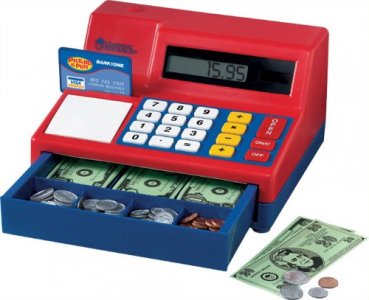
US$31.59.
Drawer fits actual-size bills.
One of the best non-scanner cash register. Solar powered some more.
Summit Junior Talking Cash Register

US$37.30.
Drawer fits actual-size bills.
The best toy cash register, because it has a working barcode scanner! (Although said to be hard to use.)
By working, I mean it reads real barcodes and the calculator will tally up the total. This is awesome. Some people even print out their own barcodes and use this cash register in their garage sale!
It also has a working loud speaker microphone.
Downside? It is fragile and spoils easily. And why is it in bright red color?
Zillionz Talking Cash Register
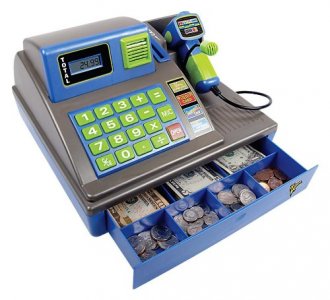
US$29.99.
Zillionz is actually a subsidiary of Summit. This is the same cash register as above, with an even worse color combination. Do they want to sell these things?
Realistic play money
We need play money to buy play food, obviously. ;-)
Melissa & Doug Play Money Set
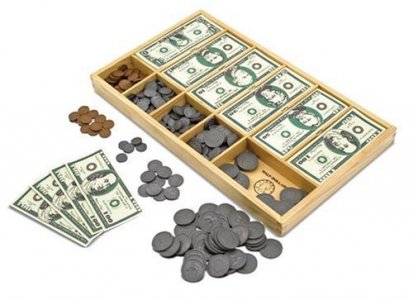
US$15.12.
Bills are actual-size. Nickels and Quarters could be better-sized.
Educational Insights Coins and Bills Deluxe Set
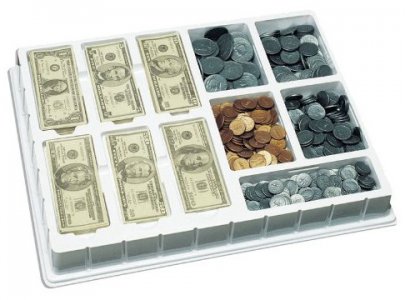
US$23.55.
Bills are smaller than actual ones. Same color as real bills.
I don't mind the bills being smaller. In fact, I think it's better for toddlers! :lol:
Bank Supplies Realistic Play Money Kit
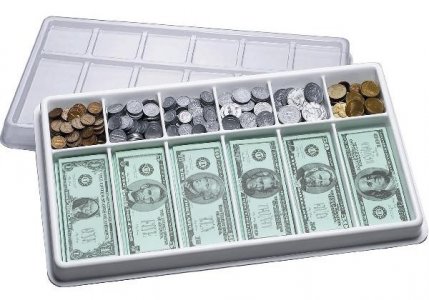
US$40.94.
Bills are actual-size.
This product is meant for practicing money handling in real situations (cashiers, bank tellers, casino employees)!
Contents
| P | N | D | Q | HD | D | $1 | $5 | $10 | $20 | $50 | $100 | |
|---|---|---|---|---|---|---|---|---|---|---|---|---|
| Melissa & Doug Play Money Set | 50 | 50 | 50 | 50 | 50 | 0 | 50 | 50 | 50 | 50 | 50 | 50 |
| Coins and Bills Deluxe Set | 100 | 100 | 100 | 100 | 50 | 0 | 100 | 50 | 50 | 50 | 25 | 25 |
| Realistic Play Money Kit | 100 | 100 | 100 | 100 | 50 | 50 | 100 | 100 | 100 | 100 | 50 | 50 |
Other currencies
I would love to get UK and Euro notes, but so far I haven't found any good ones yet.